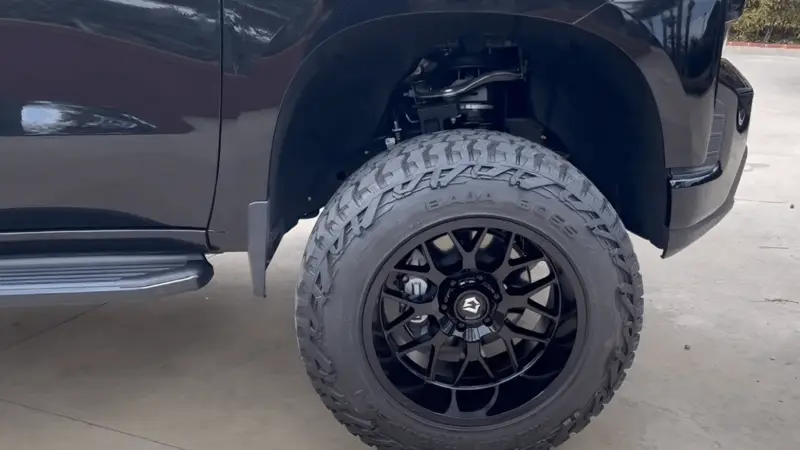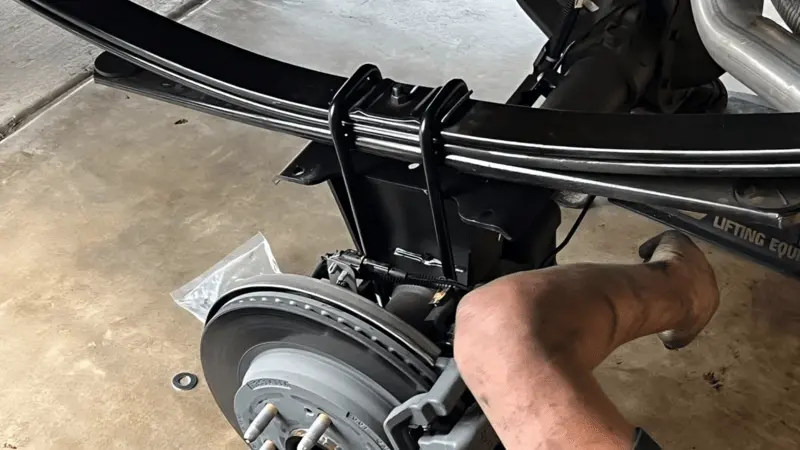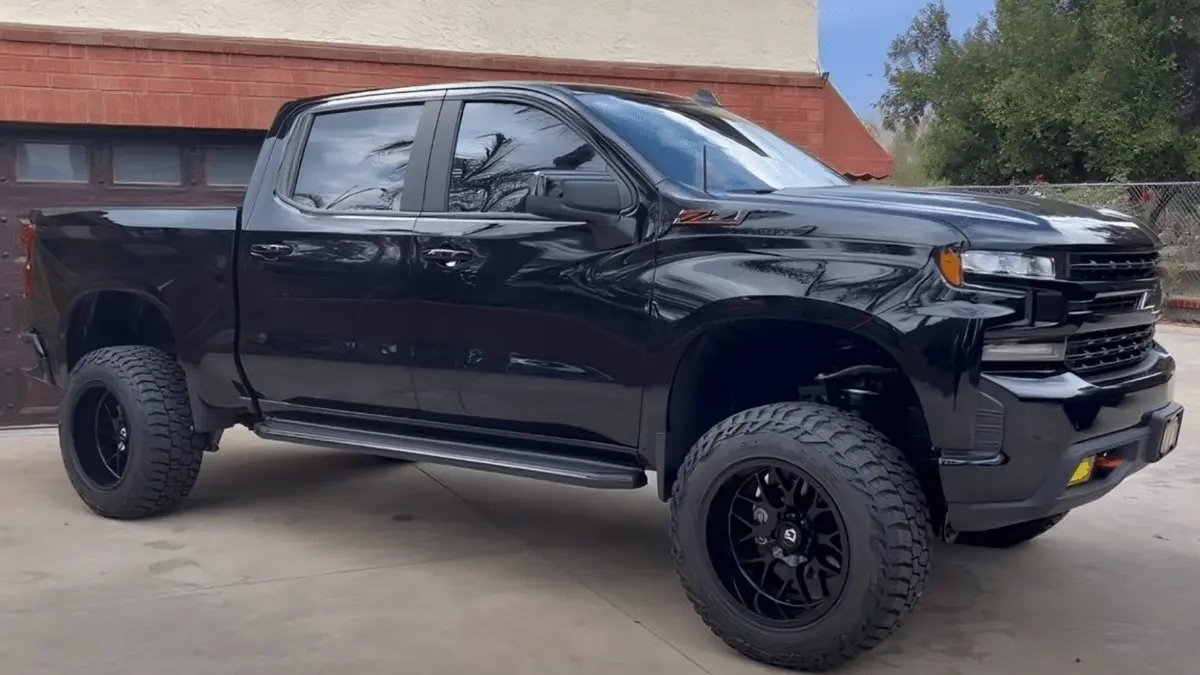As a proud owner of a Chevy Silverado 1500, consider upgrading to larger, more rugged 35-inch tires for your trusted vehicle. But before you leap, it’s essential to understand the critical question: What is the Minimum Lift For 35″ Tires Silverado 1500?
The minimum lift required to accommodate 35-inch tires on a Chevy Silverado 1500 is a 4-inch or 6-inch lift kit. This additional clearance ensures proper fitment and avoids tire rubbing issues, making it possible to harness the benefits of larger tires for improved off-road performance and a rugged appearance.
In this blog post, we’ll dive deep into the world of Chevy Silverado modifications to explore the ideal lift height needed to fit those impressive 35-inch tires.
Minimum Lift For 35″ Tires Silverado 1500

The minimum lift required for accommodating 35-inch tires on a Chevy Silverado 1500 is typically a 4- or 6-inch. However, it’s important to note that lifting the vehicle isn’t just about clearance; it also involves modifying components like shocks, steering parts, and speed sensors to maintain proper vehicle handling and functionality.
When considering a lift kit installation, it must be done correctly to avoid expensive modifications and potential damage to your vehicle. A well-executed lift will not only provide the clearance you need but also enhance the overall off-road capability and aesthetics of your Silverado.
Other Requirements
In addition to a 4- or 6-inch lift kit, there are several other requirements and considerations to accommodate 35-inch tires on a Chevy Silverado 1500 successfully:
- Adjustable Aftermarket Upper Control Arms (IFS): To maintain proper alignment and suspension geometry, adjustable aftermarket upper control arms may be necessary. These allow for fine-tuning the camber and caster angles.
- Differential Re-Gearing: When installing more extensive tires, you might need to re-gear the differentials to ensure optimal power delivery and performance. This can help in regaining lost torque and fuel efficiency.
- Fender Trimming: To prevent rubbing and ensure full tire clearance during turns and articulation, you may need to trim or modify the fender wells. This step is essential to avoid damaging the tires and the vehicle’s body.
- Minimum 16″ Negative Offset Rims: The choice of rims is critical. For 35-inch tires, you typically need rims with at least 16 inches of negative offset. This provides the necessary spacing and clearance for the larger tires.
- Relocation of Crash Bars (IFS): Some Silverado models have impact or crash bars on the independent front suspension (IFS). These may need to be relocated to accommodate the larger tires and prevent interference.
- Speedometer Recalibration: Installing larger tires can lead to an inaccurate speedometer reading. Recalibrating the speedometer is essential to maintain accurate speed and mileage measurements.
Preparation Before You Lift Your Silverado 1500

Before you lift your Chevy Silverado 1500, there are several crucial preparations and considerations to remember. Proper preparation is key to ensuring a successful lift and preventing issues. Here’s a comprehensive guide to the steps you should take before lifting your Silverado:
- Research and Planning: Begin by thoroughly researching the lift kit options available for your Silverado. Consider your intended use (off-road, towing, aesthetics) and budget. Choose a lift height that aligns with your needs, whether a 4-inch or 6-inch lift.
- Consult the Manual: Review your Silverado’s owner’s manual and service documentation to understand its specifications and requirements. This will guide the right lift kit and components needed.
- Budget Analysis: Assess the total cost of the lift project. It’s not just about the lift kit; consider additional expenses like tires, rims, re-gearing, and professional installation if required.
- Component Requirements: Determine which components you need for a complete lift. This includes the lift kit, shocks, upper control arms (UCAs), and potentially other accessories like differential drop kits or steering modifications.
- Choosing Tires and Wheels: Select the appropriate 35-inch tires and rims. Ensure they are compatible with your Silverado’s bolt pattern and backspacing requirements. Take into account the offset, as mentioned earlier.
- Professional Installation or DIY: Decide whether you’ll perform the installation yourself or hire a professional mechanic or off-road specialist. Remember that a DIY approach requires the right tools and a good understanding of your vehicle’s mechanics.
- Alignment and Maintenance: Consider the need for a professional wheel alignment after the lift to ensure proper handling and tire wear. Additionally, consider any required maintenance on other vehicle systems, such as brakes or steering components.
- Legal and Safety Considerations: Be aware of local laws and regulations regarding lifted vehicles, including headlight height and tire coverage. Ensure your lift kit and modifications comply with these regulations to avoid legal issues.
- Insurance: Contact your insurance provider to discuss how the lift might affect your coverage and premiums. Some companies may need to adjust their policy to reflect the changes.
- Test Drive and Adjustment: After the lift kit is installed, take your Silverado for a test drive to ensure everything operates as expected. Be prepared to make necessary adjustments to components like the alignment or the speedometer calibration.
How To Lift Your Silverado 1500?

Lifting your Chevy Silverado 1500 can enhance its off-road capabilities, provide more ground clearance, and allow for the installation of larger tires. Here’s a general guide on how to lift your Silverado:
Tools and Materials:
- Lift kit (4-inch or 6-inch, depending on your preference)
- Jack and Jack stands
- Lug wrench
- Wrenches and sockets
- Torque wrench
- Wheel chocks
- Safety glasses
- Brake fluid (if needed)
Step-by-Step Instructions:
Safety Precautions: Park on a level surface and engage the parking brake.
Wear safety glasses to protect your eyes during the installation.
Wheel Removal: Loosen the lug nuts on all four wheels, but do not remove them.
Jack and Secure the Vehicle: Use a jack to lift the vehicle. Place jack stands under the frame for added safety.
Ensure the vehicle is stable on the jack stands before continuing.
Remove the Wheels: Fully remove the lug nuts and take off the wheels.
Front Suspension: For the front suspension, follow these steps:
- Disconnect the front sway bar.
- Disconnect the tie rods and upper control arms (UCAs).
- Carefully lower the front differential.
- Install the new lift components, including the new UCAs.
- Reconnect the tie rods, sway bar, and differential.
Rear Suspension: For the rear suspension, follow these steps:
- Disconnect the rear sway bar.
- Remove the rear shocks and rear leaf spring shackles.
- Install the new lift components, including rear blocks and longer U-bolts.
- Reconnect the sway bar, shocks, and leaf spring shackles.
Torque Specifications: Ensure all bolts are tightened to the manufacturer’s specified torque settings using a torque wrench.
Brake Line Extension (If Necessary): Depending on the lift, you may need to extend the brake lines to accommodate the new suspension height.
RELATED: What Size Lift For 33 Inch Tires Silverado
FAQs
1. Can I Install 35-inch Tires On A Stock (Non-Lifted) Chevy Silverado 1500?
In most cases, a stock Silverado 1500 cannot accommodate 35-inch tires without rubbing or clearance issues. A lift kit is typically required to provide the necessary clearance.
2. What Is The Minimum Lift Required For 35-inch Tires On A Silverado 1500?
To fit 35-inch tires, a 4-inch or 6-inch lift is commonly recommended. The specific lift height may vary based on your Silverado’s model year and individual suspension setup.
3. Do I Need To Modify Any Other Components When Lifting 35-inch Tires?
Yes, apart from the lift kit, you may need to address other components like shocks, and upper control arms (UCAs) and potentially re-gear the differentials for optimal performance.
4. Are There Legal Restrictions Or Concerns When Installing 35-inch Tires And A Lift On My Silverado 1500?
There can be legal regulations regarding lifted vehicles, including headlight height and tire coverage. It’s essential to ensure that your modifications comply with local laws to avoid potential legal issues.
5. How Does Lifting A Silverado 1500 For 35-Inch Tires Affect Handling?
Lifting your Silverado can alter its handling characteristics. Consider the intended use of your vehicle and possibly invest in additional components like aftermarket shocks and suspension upgrades to maintain ride comfort and performance.
Final Discussion
Understanding the minimum lift required for 35-inch tires on a Chevy Silverado 1500 is vital for those seeking improved off-road capabilities and a striking appearance. Opting for a 4-inch or 6-inch lift kit not only provides the necessary clearance but also contributes to enhanced ground clearance and rugged aesthetics. However, it’s essential to consider the specific model year of your Silverado and to adhere to local regulations regarding lifted vehicles. Making the right lift choice ensures you can enjoy the full potential of 35-inch tires while maintaining a balanced blend of performance and style for your Silverado.

Eric L. Friedman is a car expert who has worked on Chevy and GMC trucks for over 10 years. He started AutoYolo to help people fix their own cars. On the blog, he shares easy tips, step-by-step guides, and repair advice to make car problems less stressful and more affordable.

